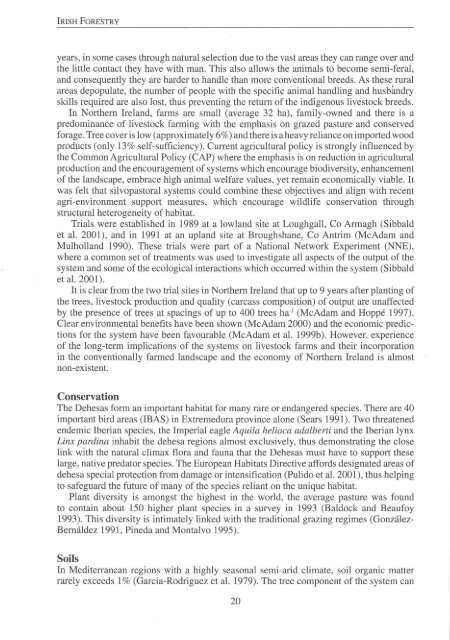Download Full PDF - 41.38 MB - The Society of Irish Foresters
Download Full PDF - 41.38 MB - The Society of Irish Foresters
Download Full PDF - 41.38 MB - The Society of Irish Foresters
Create successful ePaper yourself
Turn your PDF publications into a flip-book with our unique Google optimized e-Paper software.
-----------------------------------------------------------------------------------,.<br />
IRISH FORESTRY<br />
years, in some cases through natural selection due to the vast areas they can range over and<br />
the little contact they have with man. This also allows the animals to become semi-feral,<br />
and consequently they are harder to handle than more conventional breeds. As these rural<br />
areas depopulate, the number <strong>of</strong> people with the specific animal handling and husbandry<br />
skills required are also lost, thus preventing the return <strong>of</strong> the indigenous livestock breeds.<br />
In Northern Ireland, farms are small (average 32 ha), family-owned and there is a<br />
predominance <strong>of</strong> livestock farming with the emphasis on grazed pasture and conserved<br />
forage. Tree cover is low (approximately 6%) and there is a heavy reliance on imported wood<br />
products (only 13% self-sufficiency). Current agricultural policy is strongly influenced by<br />
the Common Agricultural Policy (CAP) where the emphasis is on reduction in agricultural<br />
production and the encouragement <strong>of</strong> systems which encourage biodiversity, enhancement<br />
<strong>of</strong> the landscape, embrace high animal welfare values, yet remain economically viable. It<br />
was felt that silvopastoral systems could combine these objectives and align with recent<br />
agri-environment support measures, which encourage wildlife conservation through<br />
structural heterogeneity <strong>of</strong> habitat.<br />
Trials were established in 1989 at a lowland site at Loughgall, Co Armagh (Sib bald<br />
et al. 2001), and in 1991 at an upland site at Broughshane, Co Antrim (McAdam and<br />
Mulholland 1990). <strong>The</strong>se trials were part <strong>of</strong> a National Network Experiment (NNE),<br />
where a common set <strong>of</strong> treatments was used to investigate all aspects <strong>of</strong> the output <strong>of</strong> the<br />
system and some <strong>of</strong> the ecological interactions which occurred within the system (Sibbald<br />
et al. 2001).<br />
It is clear from the two trial sites in Northern Ireland that up to 9 years after planting <strong>of</strong><br />
the trees, livestock production and quality (carcass composition) <strong>of</strong> output are unaffected<br />
by the presence <strong>of</strong> trees at spacings <strong>of</strong> up to 400 trees ha- 1 (McAdam and Hoppe 1997).<br />
Clear environmental benefits have been shown (McAdam 2000) and the economic predictions<br />
for the system have been favourable (McAdam et al. 1999b). However, experience<br />
<strong>of</strong> the long-term implications <strong>of</strong> the systems on livestock farms and their incorporation<br />
in the conventionally farmed landscape and the economy <strong>of</strong> Northern Ireland is almost<br />
non-existent.<br />
Conservation<br />
<strong>The</strong> Dehesas form an important habitat for many rare or endangered species. <strong>The</strong>re are 40<br />
important bird areas (lEAS) in Extremedura province alone (Sears 1991). Two threatened<br />
endemic Iberian species, the Imperial eagle Aquila heliaca adalberti and the Iberian lynx<br />
Linx pardina inhabit the dehesa regions almost exclusively, thus demonstrating the close<br />
link with the natural climax flora and fauna that the Dehesas must have to support these<br />
large, native predator species. <strong>The</strong> European Habitats Directive affords designated areas <strong>of</strong><br />
dehesa special protection from damage or intensification (Pulido et al. 2001), thus helping<br />
to safeguard the future <strong>of</strong> many <strong>of</strong> the species reliant on the unique habitat.<br />
Plant diversity is amongst the highest in the world, the average pasture was found<br />
to contain about 150 higher plant species in a survey in 1993 (Baldock and Beaufoy<br />
1993). This diversity is intimately linked with the traditional grazing regimes (Gonzalez<br />
Bernaldez 1991, Pineda and Montalvo 1995).<br />
Soils<br />
In Mediterranean regions with a highly seasonal semi-arid climate, soil organic matter<br />
rarely exceeds 1 % (Garcia-Rodriguez et al. 1979). <strong>The</strong> tree component <strong>of</strong> the system can<br />
20

















